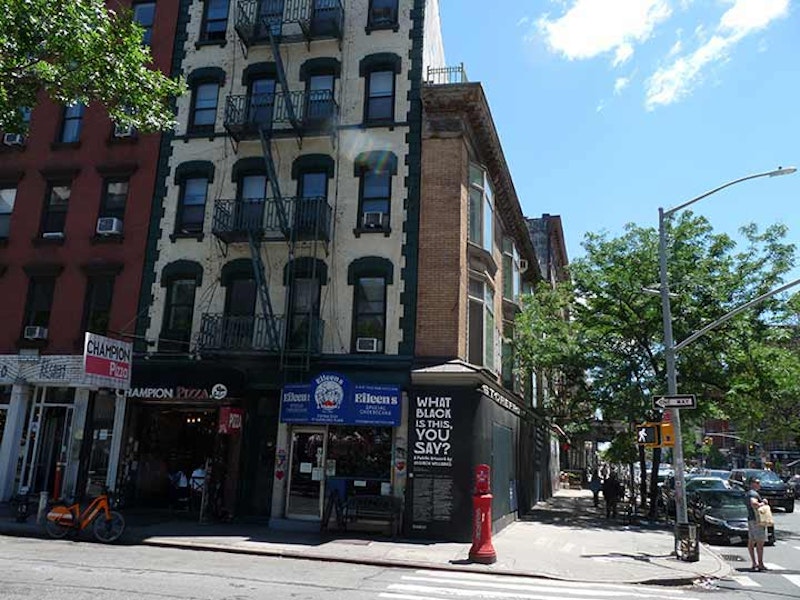Kenmare Street runs east to west from Lafayette St. to the Bowery where it changes its name to Delancey, slotted in between Broome and Spring. However, Kenmare Street’s numbering runs east to west, so officially, it begins at the Bowery. Kenmare St. didn’t exist on Manhattan maps before 1911; in that year, traffic from the new Williamsburg Bridge (still mainly of the horse and cart variety) caused Delancey St. to be widened and a new street opened west of the Bowery as far as Lafayette, itself a new Manhattan street at the time; it was extended south from Lafayette Pl. in the Cooper Square area. Early-20th century politician and labor leader “Big Tim” Sullivan had Kenmare St. named for the location in Ireland where his mother was born. The street is located in a region known as Nolita, or “North of Little Italy” and it touches on that neighborhood as well as the expanding Chinatown.
The BMT got busy with Kenmare St. right away, running the BMT Nassau-Jamaica line under it in 1913 on its way to crossing the mighty Williamsburg.
What may be one of the narrowest buildings in NYC is here, at the NE side of #87-97 Kenmare at Cleveland Pl. Here is what it looked like in 1940; its bay windows have been retained. It’s just three-and-a-half feet wide here, extending to 19 feet as you go east! This arrangement came about when Kenmare St. was bruited through #15 Marion St., now known as Cleveland Pl., leaving a sliver of property that was developed into a building. Tom Miller, the indefatigable Daytonian in Manhattan, has the story of its various colorful tenants over the years, including an interior shot.

Looking south on Cleveland Pl., renamed from Marion St. to honor President Grover Cleveland (1837-1908), who was Governor of NY State, toward the domed former NYPD Headquarters, 240 Centre St., located in a wedge between Centre, Grand, Broome, and Centre Market Place. Currently a luxury apartment building called Police Building Apartments, it was designed by Hoppin & Krohn and completed in 1909 just as the Beaux Arts movement was winding down and modernism was around the corner. The lions in front look more fierce than the two at the New York Public Library—as befits Police HQ. It was converted to luxury use in 1988, am early harbinger of the luxe trend that would take hold in Soho in the following decade.

There’s little you will find along Kenmare St. to indicate that the street is newer than its brother streets; but I’d love to see photographs taken during its construction or just after. These apartment buildings went up shortly after the street was opened in 1911 and exhibit post Beaux Arts styling as well as the new streamlining that was beginning to take effect. Certainly good to see the bustling crowds returning; I recall the walk I did on 34th Street in July 2020. I was the only one around, as most were indoors at the height of the pandemic.

Here’s the entrance to Russ & Daughters Cafe on Allen St., a smaller version of the store on Houston St.. The entrance at #127 Orchard features a minimalist sign that looks nothing like this. Branches have popped up in places like the Brooklyn Navy Yard and Hudson Yards.
Polish immigrant Joel Russ opened a pickled herring shop on Orchard St. in 1914. According to Historic Restaurants and Shops of New York, Russ had an argumentative personality, not an asset in the retail biz, so he put his three personable daughters to work behind the counter. The business evolved into a gourmet seafood delicacies emporium, still with a vintage 1940s neon sign on Houston St.

Lower East side residents of the late-1800s and early-1900s would be surprised, and some bemused, to discover that their apartments had been converted into museum space. That’s exactly what happened at #97 Orchard St. just north of Broome, in apartments at one time rented by seamstress Nathalie Gumpertz, garment presser Abram Rogarshevsky, and the Confino and Baldizzi families, all representing different eras in the building’s long history. Originally constructed in 1867 without gas, hot water or flush toilets, it was like most of the other tenements in the area. Owners only installed these amenities after housing laws were passed around the turn of the 20th century. During the last few years, tours have met and souvenirs have been purchased in the corner space at Delancey and Orchard, shown here.

I thought I’d recognized these “Oyster Bar” neon signs at the Grey Lady restaurant, in the old bank building. They’re from the former Oyster Bar restaurant at 7th Ave. and W. 55th St.. Grey Lady purchased the signs at auction in 2014 after the original Oyster Bar restaurant closed earlier that year.
—Kevin Walsh is the webmaster of the award-winning website Forgotten NY, and the author of the books Forgotten New York (HarperCollins, 2006) and also, with the Greater Astoria Historical Society, Forgotten Queens (Arcadia, 2013)

